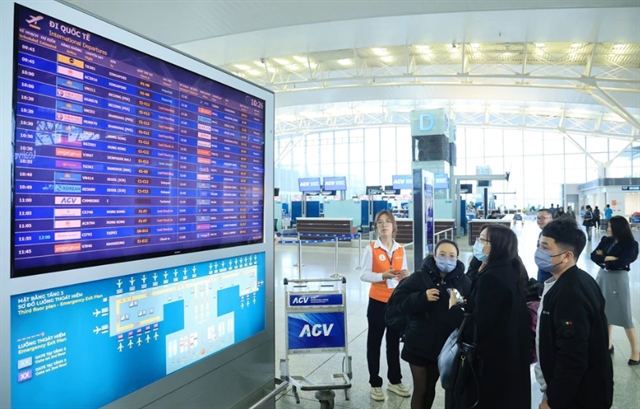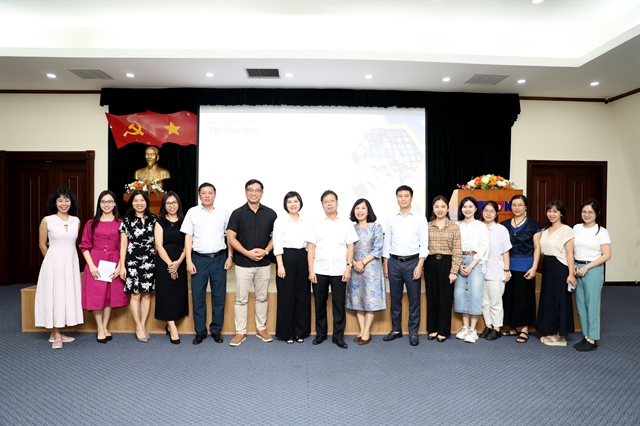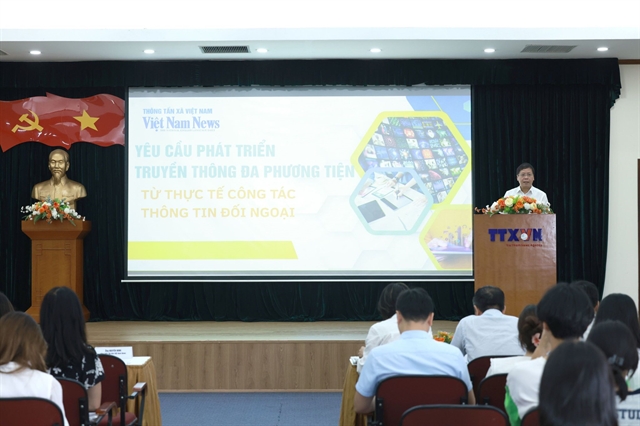 Economy
Economy

 |
| Distingushed guests and speakers take group photo after the workshop. — VNS Photos Đoàn Tùng |
HÀ NỘI — Public diplomacy is crucial in helping people at home and abroad understanding Việt Nam, its values, people, policies and achievements and refuting misinformation about the country.
That was the message from Nguyễn Minh, Editor-in-Chief of Việt Nam News, at the workshop "Multimedia Communications in Public Diplomacy" on Thursday.
 |
| Nguyễn Minh, Editor-in-Chief of Việt Nam News. |
As Việt Nam integrates internationally, public diplomacy, he believes, deserves more attention. He said multimedia communications had become essential in creating ties and promoting mutual understandings between Việt Nam and other countries.
"Multimedia channels allow Việt Nam to express its perspectives not only through text but also images, sounds and videos, increasing influence and persuasion," Minh said.
Assoc. Prof. Dr. Đỗ Thị Thu Hằng, Head of the Journalism Department under the Vietnam Journalists' Association, said digital transformation centres around the change of mindset and working techniques from a traditional to a digital environment.
She cited digital transformation as a factor that has given rise to multimedia and multi-platform journalism and digital ecosystems in media outlets.
"The three main building blocks of multimedia journalism are text, sound and visual," said Hằng.
 |
| Dr. Đỗ Anh Đức, Vietnam National University, Hanoi's University of Social Sciences and Humanities addresses the conference. Photo Bảo Ngọc |
Dr. Đỗ Anh Đức, a lecturer at the University of Social Sciences and Humanities, underlined five challenges in public diplomacy, related to awareness, strategy, context, competition and journalism profits.
He said the goal of public diplomacy is not only to "inform what happens in Việt Nam" but more importantly to "create influence and experience" on the target audience.
The lecturer also highlighted five opportunities for the country in public diplomacy, which involve regime, reputation, materials, young people and media channels.
.JPG) |
| A snapshot of the presentation by Việt Nam News reporters Cao Thị Ly Ly and Đinh Vũ Nhật Hồng. |
Cao Thị Ly Ly and Đinh Vũ Nhật Hồng, reporters of Việt Nam News, shared several practical tips to improve online engagement, such as embedding popular keywords in titles, captions, teaser and lead paragraphs of articles to boost viewership.
"We should use at least three and at most five main keywords in every article," said Ly.
The reporters suggested using the Google Trends tool to identify the most popular keywords every day on the Google search engine.
Nguyễn Quang Vũ, Deputy Director of the Vietnam News Agency Television Centre (Vnews), said most mainstream media outlets had engaged in multimedia.
Some advanced ones have employed AI for virtual studios and anchors which attract mass attention. However, multimedia's rise has also seen harmful misinformation pages emerge.
"The task now is to lure audiences away from those malicious pages and back to official sources," said Vũ, noting their Channel Đối Diện combats fake news head-on.
 |
| Delegates attend the conference. |
Nguyễn Hoàng Nhật, Deputy Editor-in-Chief of Vietnam Plus, said audiences now consume news primarily on smartphones rather than print or desktop, citing over two million page views two days prior with over 70 per cent from mobiles.
With more than 70 million social media users in Việt Nam, he stressed the need for media outlets to leverage these platforms.
He also quoted a January 2024 survey showing Vietnamese spend 6h18m online daily, most on social media (2h25m) versus video/TV (2h21m) and news reading (1h47m).
Nguyễn Phong Anh, a lecturer at the University of Social Sciences and Humanities, said AI is advancing rapidly in sophistication, scale, diversity and personalisation, potentially reaching US$2 trillion in market size by 2030.
AI offers opportunities to automate mundane journalistic tasks, enhance audio-visuals, create new formats like AI-generated music and virtual reality, optimise advertising and customise user interfaces.
However, easier AI access means more junk content and sophisticated fake news, data bias risks,and the potential loss of advantages in some professions. — VNS

.jpg)


